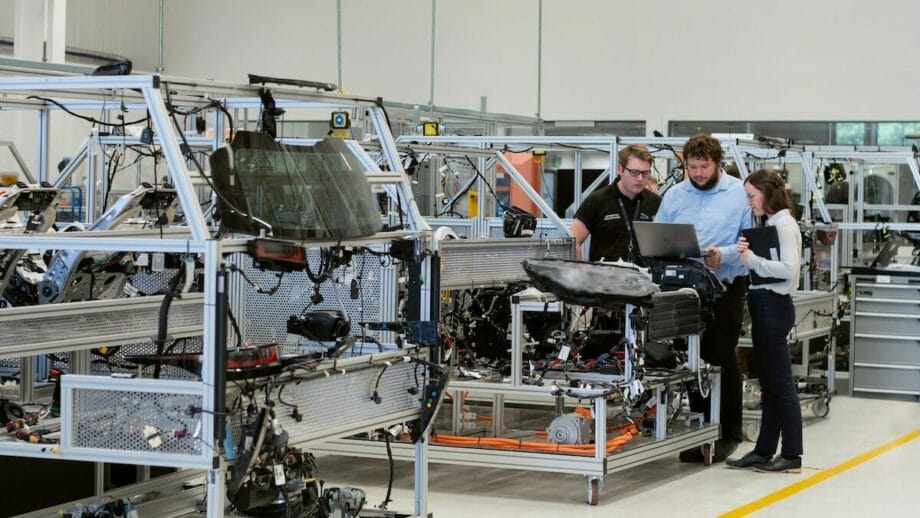The global Manufacturing Operations Management (MOM) software market is experiencing an extraordinary surge, fueled by accelerated technological innovations, digital transformation efforts, and the escalating intricacies of contemporary manufacturing processes.
Valued at an estimated US$20.89 billion in 2025, the market is anticipated to soar to US$69.8 billion by 2032, recording an impressive CAGR of 18.8% throughout the forecast period.
This article delves into the market dynamics, growth drivers, regional variations, technological advancements, and future prospects that are defining the MOM software landscape.
Overview of Manufacturing Operations Management (MOM) Software
Manufacturing Operations Management (MOM) software encompasses a sophisticated array of tools aimed at enhancing manufacturing operations across various dimensions, including production planning, execution, quality assurance, and supply chain logistics.
By consolidating Manufacturing Execution Systems (MES), Quality Management Systems (QMS), and Advanced Planning & Scheduling (APS) functionalities, MOM software empowers manufacturers to realize enhanced productivity, increased efficiency, and superior operational transparency.
“By consolidating Manufacturing Execution Systems (MES), Quality Management Systems (QMS), and Advanced Planning & Scheduling (APS) functionalities, MOM software empowers manufacturers to realize enhanced productivity, increased efficiency, and superior operational transparency.” – according to Surplus.net
Primary Goals of MOM Software
- Optimize production workflows.
- Minimize operational downtime.
- Guarantee adherence to product quality standards.
- Enhance supply chain transparency.
- Facilitate real-time decision-making.
In light of intensifying global competition, industries are progressively adopting MOM solutions to capitalize on real-time analytics, predictive maintenance, and smart factory technologies, thereby fostering cost efficiencies and better resource allocation.

Drivers of Market Expansion
The growth of the MOM software market is spurred by multiple pivotal factors, including:
1. Digital Transformation in Manufacturing
Industries are committing substantial resources to digital technologies such as Artificial Intelligence (AI), Internet of Things (IoT), and cloud solutions with the aim of modernizing operational frameworks.
MOM software fundamentally underpins smart manufacturing by facilitating real-time monitoring, predictive insights, and automation.
2. Growing Demand for Operational Efficiency
Manufacturers in sectors such as automotive, aerospace, pharmaceuticals, and electronics are under significant pressure to refine production stages, curtail waste, and elevate throughput.
MOM software enables process optimization and reduces cycle durations, ultimately enhancing efficiency and profitability.
3. Embrace of Industry 4.0 Framework
The Industry 4.0 model promotes interlinked devices, intelligent sensors, and data-centric decision-making. MOM software seamlessly integrates with Industrial IoT technologies, allowing for real-time production supervision, predictive maintenance, and workflow automation, thereby bolstering smart factory initiatives.
4. Stringent Regulatory Compliance and Quality Assurance
Imposing regulations across various sectors, particularly pharmaceuticals, automotive, and aerospace, necessitate meticulous documentation, traceability, and quality management. MOM software assists in adhering to ISO, FDA, and other regulatory mandates, mitigating risks associated with non-compliance.
5. Increasing Complexity of Supply Chains
As global supply chains grow increasingly intricate due to outsourcing, multi-location manufacturing, and expansive logistics networks, MOM software provides end-to-end visibility, equipping manufacturers to navigate disruptions, optimize inventory, and refine production planning.
Market Segmentation Insights
The MOM software market can be categorized by component type, application, industry vertical, and geography, each evincing distinct adoption trends and growth prospects.
Component Type
- Software: Projected to capture roughly 70.2% of market share by 2025, propelled by its pivotal role in process enhancement, real-time oversight, and predictive analysis.
- Services: Comprising consulting, implementation, training, and support services, crucial for the seamless deployment and integration of MOM solutions.
Application Areas
- Manufacturing Execution Systems (MES): Commands the market, accounting for over 34.8% of revenue due to the global emphasis on real-time production oversight and efficiency drives.
- Quality Management Systems (QMS): Concentrates on quality assurance, compliance with regulatory mandates, and defect mitigation.
- Advanced Planning & Scheduling (APS): Focuses on optimizing production timetables, resource distribution, and capacity planning.
- Performance Analysis and Reporting: Enables stakeholders to utilize data-driven insights for operational refinement.
Industry Vertical Analysis
- Automotive: High adoption levels driven by intricate assembly lines and rigorous quality parameters.
- Pharmaceuticals: Adoption is propelled by the need for regulatory compliance and production effectiveness.
- Aerospace & Defense: Demand arises from requirements for precision manufacturing and traceability.
- Electronics & Semiconductor: Adoption stems from rapid innovation cycles and automation imperatives.
- Consumer Goods: Focuses on enhancing production throughput and minimizing operational expenditures.
Regional Market Dynamics
1. North America – Dominant Market
- Boasts a 35.6% market share in 2025, primarily driven by the U.S. and Canada.
- Advanced technological infrastructure and robust manufacturing sectors bolster MOM uptake.
- Smart factory initiatives and government-facilitated Industry 4.0 programs underpin ongoing growth.
2. Asia Pacific – Rapidly Expanding Region
- Accelerated industrialization in countries like China, India, Japan, and South Korea drives MOM software adoption.
- The burgeoning manufacturing hubs, demands for high labor efficiency, and government incentives promote digital transformation.
- Regional CAGR outstrips global averages due to vigorous industrial progress.
3. Europe
- There is robust adoption of MES and QMS systems within the automotive, pharmaceuticals, and aerospace domains.
- Growth is propelled by stringent quality requirements and Industry 4.0 policies, especially in Germany, France, and the UK.
4. Latin America, Middle East & Africa
- Emerging markets exhibit increasing investments in automation and digital solutions.
- Growth prospects stem from the outsourcing of manufacturing functions and heightened government focus on industrial upgrading.

Technological Developments in MOM Software
- Artificial Intelligence and Machine Learning: AI-driven predictive analytics augment maintenance schedules, production forecasting, and quality control, thereby decreasing operational expenses and downtime.
- Industrial IoT Integration: IoT-capable MOM software provides real-time data from manufacturing floors, sensors, and machinery, fostering proactive decision-making and alleviating production bottlenecks.
- Cloud-Based Solutions: The adoption of cloud technologies minimizes infrastructure expenditures, enhances scalability, and permits remote oversight and management of manufacturing tasks.
- Digital Twin Technology: Digital twins replicate production processes digitally, allowing manufacturers to simulate workflows, predict outcomes, and enhance operations prior to implementation.
- Data Analytics and Business Intelligence: Advanced analytics equips manufacturers to monitor KPIs, optimize resource distribution, and bolster production planning, facilitating enlightened decision-making.
Competitive Landscape
The MOM software arena is characterized by fierce rivalry, with preeminent vendors emphasizing product innovation, strategic alliances, and mergers and acquisitions.
Leading Industry Players:
- Siemens AG: Provides integrated MOM solutions, prioritizing Industry 4.0 implementation.
- Rockwell Automation: Supplies MES solutions enriched with AI and IoT functionalities.
- Honeywell International: Specializes in automation, predictive maintenance, and smart manufacturing offerings.
- Dassault Systèmes: Delivers cloud-based MOM software, enhancing collaboration and digital twin capabilities.
- ABB Ltd.: Focuses on smart factory solutions and MES integration.
- L&T Technology Services (LTTS): Collaborates with Danfoss for next-gen MES deployment, augmenting the digital framework and IT/OT security.
Case Study: L&T Technology Services and Danfoss
In May 2023, L&T Technology Services (LTTS) forged a partnership with Critical Manufacturing to assist Danfoss in implementing a next-gen MES as part of its Smart Manufacturing agenda.
Objectives:
- Augment visibility and transparency within production lines.
- Enhance quality management and regulatory compliance.
- Fortify IT/OT security.
- Optimize time-to-market efficiencies
This collaboration underscores the increasing trend of deploying MOM software for digital transformation and operational excellence.
Investment Trends and Future Projections
- Heightened R&D Investments: Manufacturers and software providers are channeling substantial resources into R&D to innovate AI, IoT, and cloud functionalities, responding to the evolving needs of smart factories.
- Strategic Partnerships and Collaborations: Alliances between software vendors, technology consultancies, and manufacturers are expediting adoption and facilitating scalable MOM solutions.
- Emphasis on Sustainability: MOM software aids in fostering energy-efficient production, waste mitigation, and environmentally-friendly manufacturing practices, aligning with global sustainability objectives.
- Rising Demand for Tailored Solutions: Manufacturers are increasingly pursuing industry-specific MOM solutions, customized to accommodate distinct operational and regulatory demands.
Challenges Facing the MOM Software Market
Despite robust growth trajectories, the MOM market contends with several challenges:
- High Implementation Costs: Small and medium-sized enterprises (SMEs) may find it challenging to meet initial investment and integration costs.
- Data Security Risks: Cloud and IoT integration could expose manufacturing data to potential cybersecurity threats.
- Complexity of Integrating with Legacy Systems: Older manufacturing facilities might struggle to align MOM software with existing equipment.
- Limited Workforce Proficiency: Effective deployment necessitates skilled personnel, which can be scarce in emerging markets.
Strategic Recommendations for Manufacturers
To optimize MOM software adoption and return on investment, manufacturers should contemplate:
- Investing in workforce training and change management initiatives.
- Utilizing cloud-based and scalable solutions for adaptable deployment.
- Prioritizing cybersecurity and data protection strategies.
- Incorporating AI and predictive analytics for proactive operational governance.
- Implementing a modular strategy for phased deployment and minimal disruption
Conclusion

The global Manufacturing Operations Management (MOM) software market is on track for exceptional growth in the forthcoming decade. With a rising appetite from automotive, pharmaceutical, aerospace, and electronics sectors, MOM software is proving to be an indispensable asset for operational excellence, digital transformation, and smart manufacturing initiatives.
Source link: Newstrail.com.






